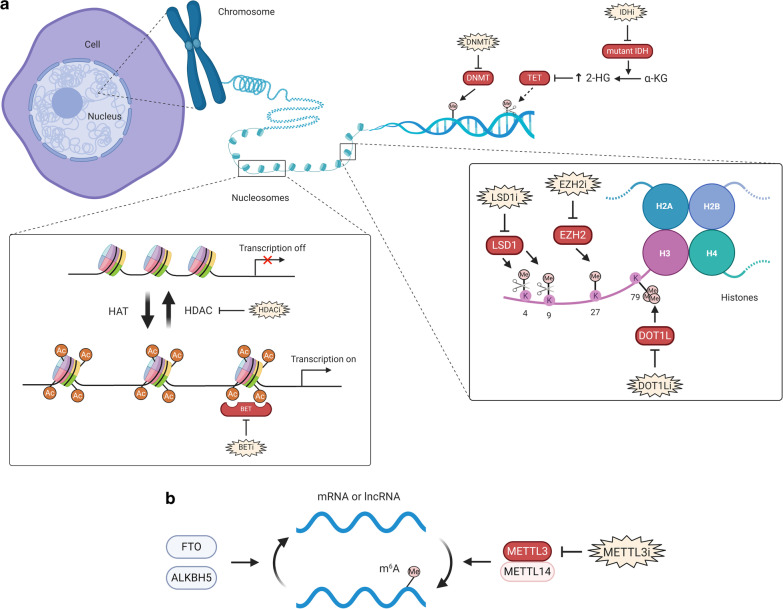Fig. 1.
The epigenetic readers, writers and erasers. (a) Histone proteins wrap around DNA to form a nucleosome, which are then compacted to form chromatins and further into chromosomes. HATs add acetyl groups and HDACs remove acetyl groups from histone lysine residues. The acetylated histones are considered as “open chromatin”, enabling gene transcription, whereas deacetylated histones are “closed chromatin” and associated with gene silencing. BET proteins recognize acetylated histones and are involved with transcriptional activation by recruiting other proteins. In comparison with histone acetylation, histone methylation can be either repressive or activating, depending on the site and degree of methylation. Different histone methyltransferases are specific to modify the lysine or arginine residues. LSD1 demethylates either the active mark of H3K4 or the repressive mark of H3K9, in a context-dependent manner. EZH2 methylates H3K27 and promotes transcription silencing. DOT1L methylates H3K79, which is an activation mark. At the DNA level, DNMTs methylate and convert cytosine to 5-methylcytosine (5mC), and TETs remove methyl groups on DNA. Mutations in genes encoding enzymes in the cellular metabolism can alter the epigenetic landscape. This is exemplified by IDH1/2 that metabolize isocitrate to α-KG. IDH1/2 mutations (gain-of-function) result in further processing of α-KG to 2-HG (“oncometabolite”), which inhibits TETs and leads to reduced DNA demethylation (increased DNA methylation state). b A multiprotein complex (consisting METTL3, METTL14 and other subunits) methylates adenosine base at the nitrogen-6 position and forms m6A in the messenger RNA. m6A modification is reversible and it can be erased by ALKBH5 and FTO. m6A reader proteins can regulate the metabolism of mRNA. For example, YTHDF2 binds to m6A and targets mRNA degradation. HAT histone acetyltransferase, HDAC histone deacetylase, BET bromodomain and extra-terminal motif proteins, LSD1 lysine-specific histone demethylase 1, EZH2 enhancer of zeste homolog 2, DOT1L disruptor of telomeric silencing 1 like, DNMT DNA methyltransferase, TET ten-eleven translocation, IDH isocitrate dehydrogenase, α-KG α-ketoglutarate, 2-HG 2-hydroxyglutarate, m6A N6-methyladenosine, METTL3 methyltransferase-like protein 3, METTL14 methyltransferase-like protein 14, ALKBH5 alkB homolog 5, FTO fat-mass and obesity associated protein

